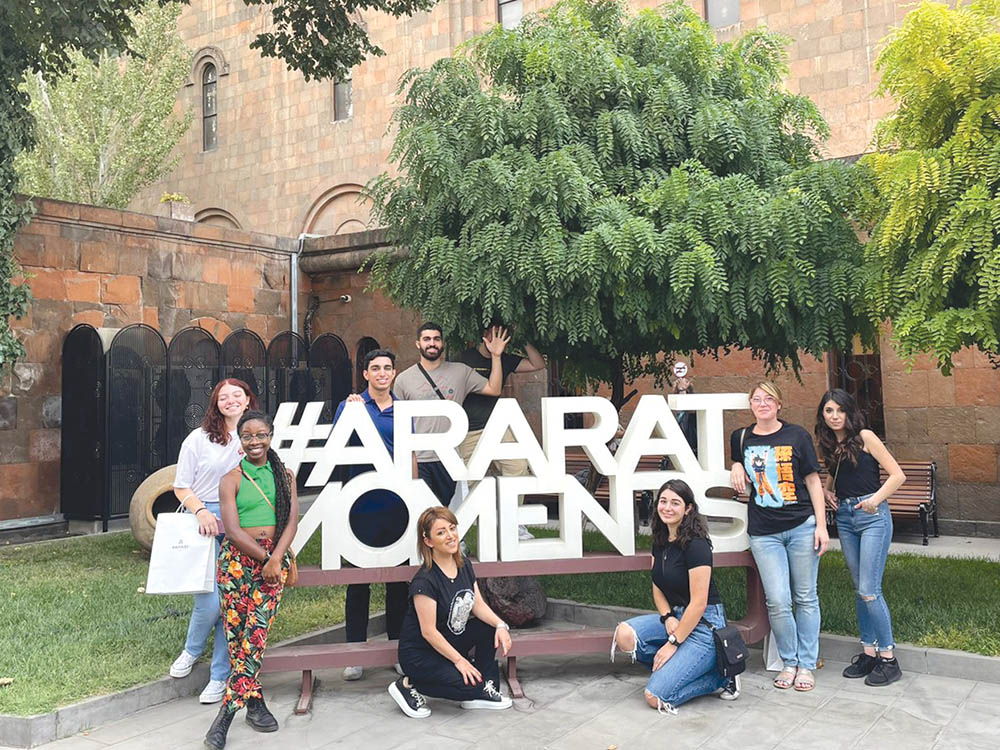
Eddy Thurber
Staff Writer
I was born and raised in Fresno, California. I never spoke Armenian as my grandparents, concerned with the redlining and segregation they and their parents experienced in the early 1900s, made sure that my parents and their siblings spoke English, that did not speak Armenian at home, and had American names. I grew up hearing the stories of how my ancestors escaped the Genocide, experiencing rich Armenian culture, and eating Armenian foods both home cooked and in restaurants across California. Despite constant exposure to Armenian culture, something was always missing. I wanted to speak the Armenian language and somehow felt disconnected from the Armenians around me who always seemed to have slightly deeper connections to their homeland and culture than I did.
Visiting Armenia for the first time has changed everything.
My preconceptions were shattered. I was insecure about my inability to speak Armenian, but upon arriving I discovered that nearly half of all speech I heard was in Russian! I was afraid that I would stand out for not dressing like an Armenian until it became clear that people would look surprised when I would wear shirts with Artsakh logos, Armenian phrases, or Genocide slogans. I did not know many ancient Armenian traditions and was worried that I would not understand cultural events until I learned that things like traditional Armenian weddings were hard to market in Armenia. A startup focused on the ancient traditional Armenian wedding ceremonies told a group that most of their contracts came from diasporan families traveling to Armenia as opposed to resident Armenians themselves. It quickly became clear to me that my ideas of Armenian identity were not common to all Armenians, specifically those living in Armenia itself. My understanding of Armenian identity across cultures quickly evolved and led to several fascinating conclusions. Armenians in the diaspora experienced the Genocide in radically different ways than did Armenians in Armenia. The ancestors of Armenians in modern Armenia were for hundreds of years under Russian rule and, while discriminated against in conventional ways, did not experience the horror of the Genocide. Their culture remained coherent over the centuries and did not face an existential threat until the wars over Artsakh. This has led to the Western Armenians who fled the Genocide and many of the Eastern Armenians who emigrated after the fall of the Soviet Union holding tightly to their culture and preserving their language and traditions religiously to ensure that their identity would continue through the generations and not absorb into the cultures of whatever nations they traveled to.
Many Armenians in Armenia, however, take their culture for granted. To be clear, I have heard this from their own mouths and will confidently defend this position. The Armenian costumes and other cultural traditions are rarely seen in Yerevan and the other large cities.
These discoveries were incredibly interesting. To my surprise I found I had more knowledge of Armenian traditions than many of my peers who had lived in Armenia their whole lives! I realized that there are many different paths that lead to being Armenian, and that many Armenians have completely different views of their identity than I do. This has given me more confidence in my identity and knowledge of my culture as I continue to experience my motherland through the two lenses: American and Armenian.
On the topic of learning and discovery, my experiences with American University of Armenia students are certainly worth sharing. I interacted with AUA students in two different environments: the students I lived with in the dorm, primarily international students or from distant Armenian cities and the students I met on campus who, making up a plurality of students, were from Yerevan itself. The students I met in the dorms were fascinating! I learned phrases in Syrian Arabic, Lebanese Arabic, Russian, Turkish, Dutch, and German as well as interesting cultural things about each of them. We had conversations until four in the morning about religion, the history and modern politics of Lebanon and Syria, Armenian culture, Diasporan culture, American culture, and many other subjects. The students from Yerevan were almost all very interested in America, and extremely curious about both life there and why we chose to study in Armenia. I cannot remember a single negative experience with a student at AUA, with almost everyone being very friendly when we interacted. I was extremely surprised at the openness of these students and the quality of the discussions we had in the dorms.
I am taking seven classes. Two undergraduate business courses, an undergraduate Armenian history course, a ping-pong PE class, an AUA Open Education Elementary Eastern Armenian course, and two Masters in Political Science courses. I may have jumped in over my head with those masters courses, but the professors for each of those classes were interesting, willing to work with me on any issues I had, and engaging in the classroom. The ability I had to take all these courses in so many different disciplines is thanks to the support from the Kashian Foundation Scholarship. For the first time ever the Admissions Office at AUA sent a proposal to accept five students from Fresno State. The proposal was accepted, and we are able to experience Armenia personally. We also visited historic locations around Armenia every week. We toured the Matenadaran, home of the largest collection of ancient Armenian texts, visited the monastery at Geghard and climbed the cliffs to explore the caves in the mountains, and will soon visit Etchmiadzin, center of the Armenian Orthodox faith, along with many other historical locations.
I will always be grateful for the opportunity to study, learn Armenian, and explore my history in Armenia and highly recommend that students apply for this program.
 Hye Sharzhoom Armenian Action
Hye Sharzhoom Armenian Action